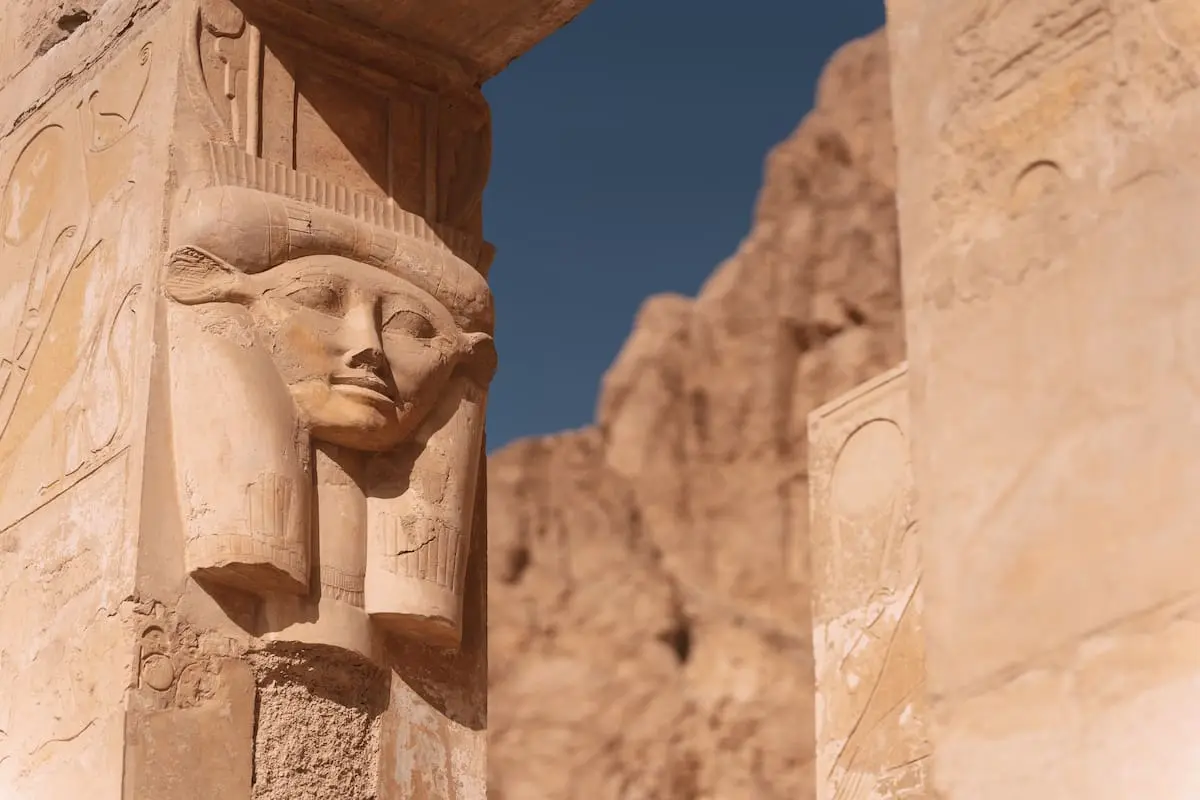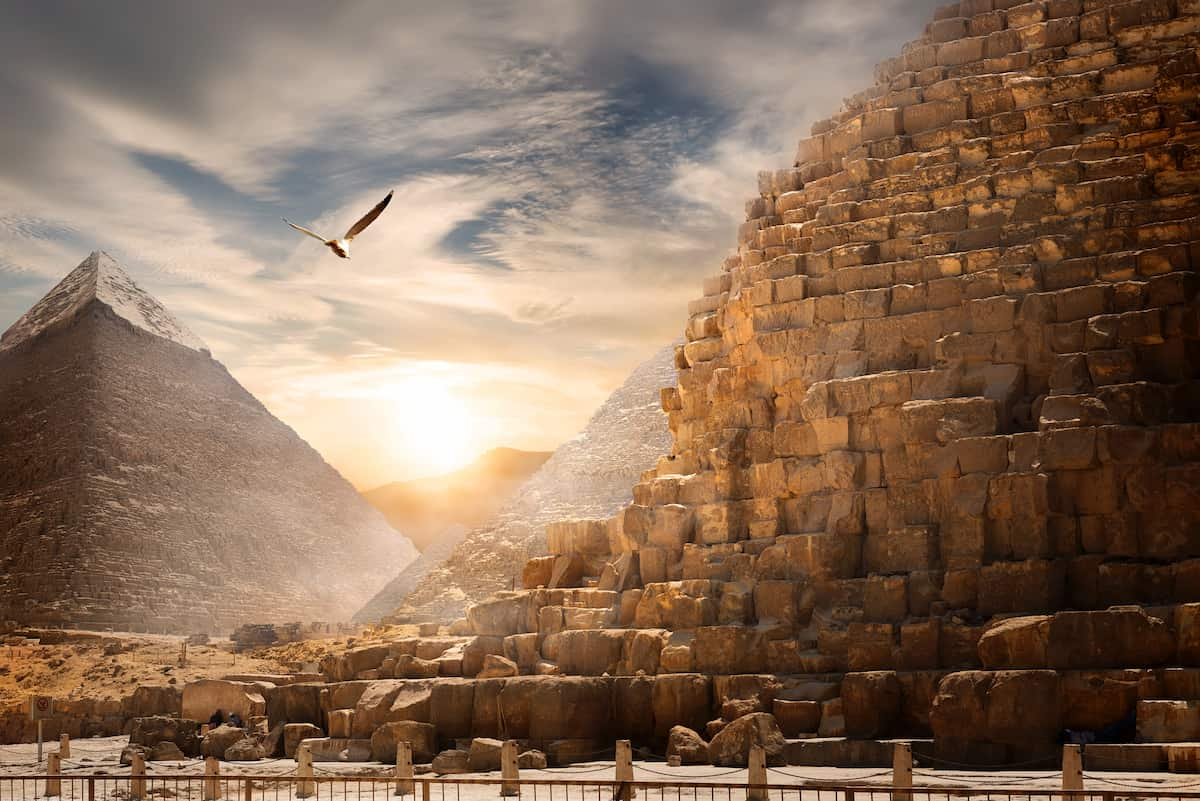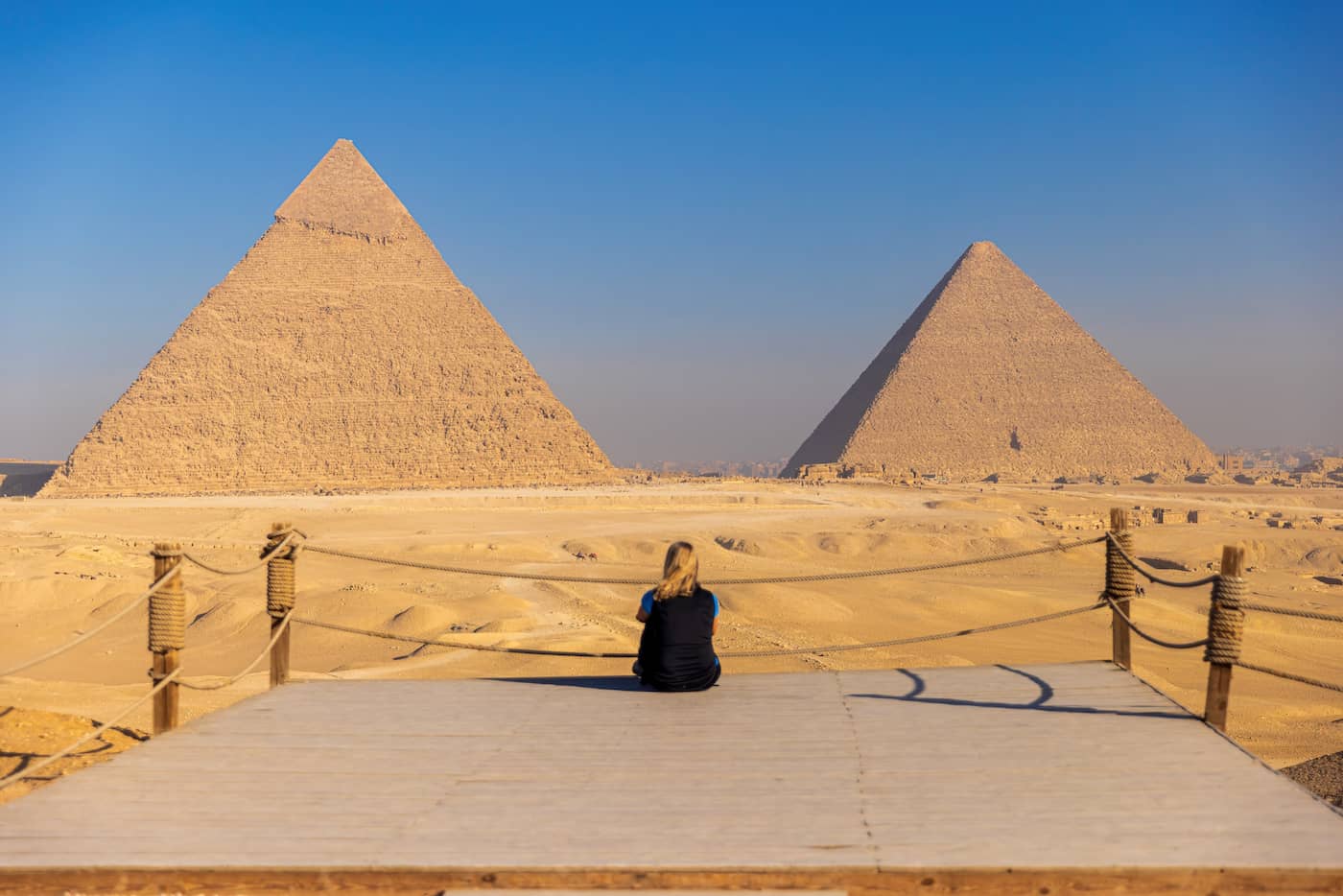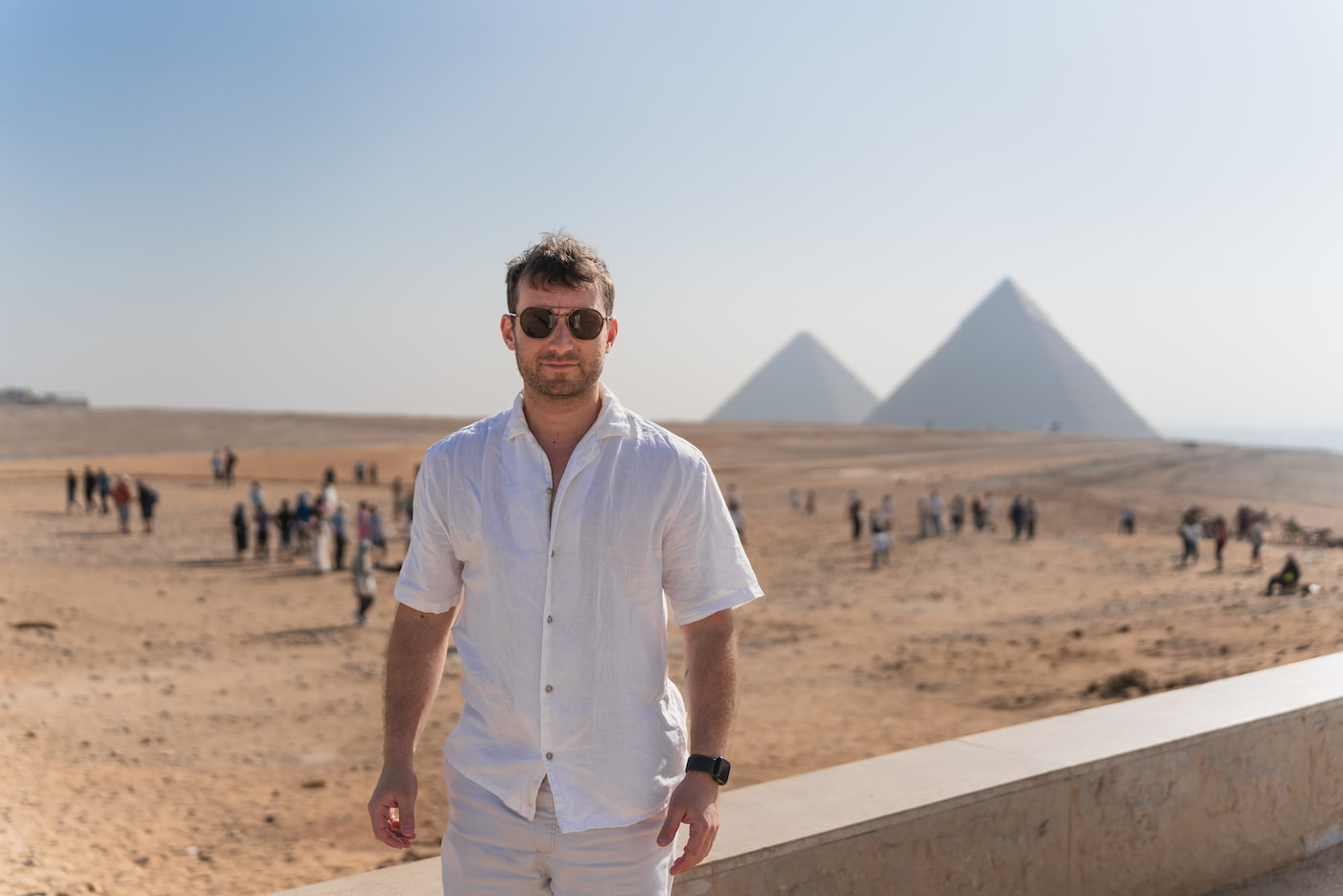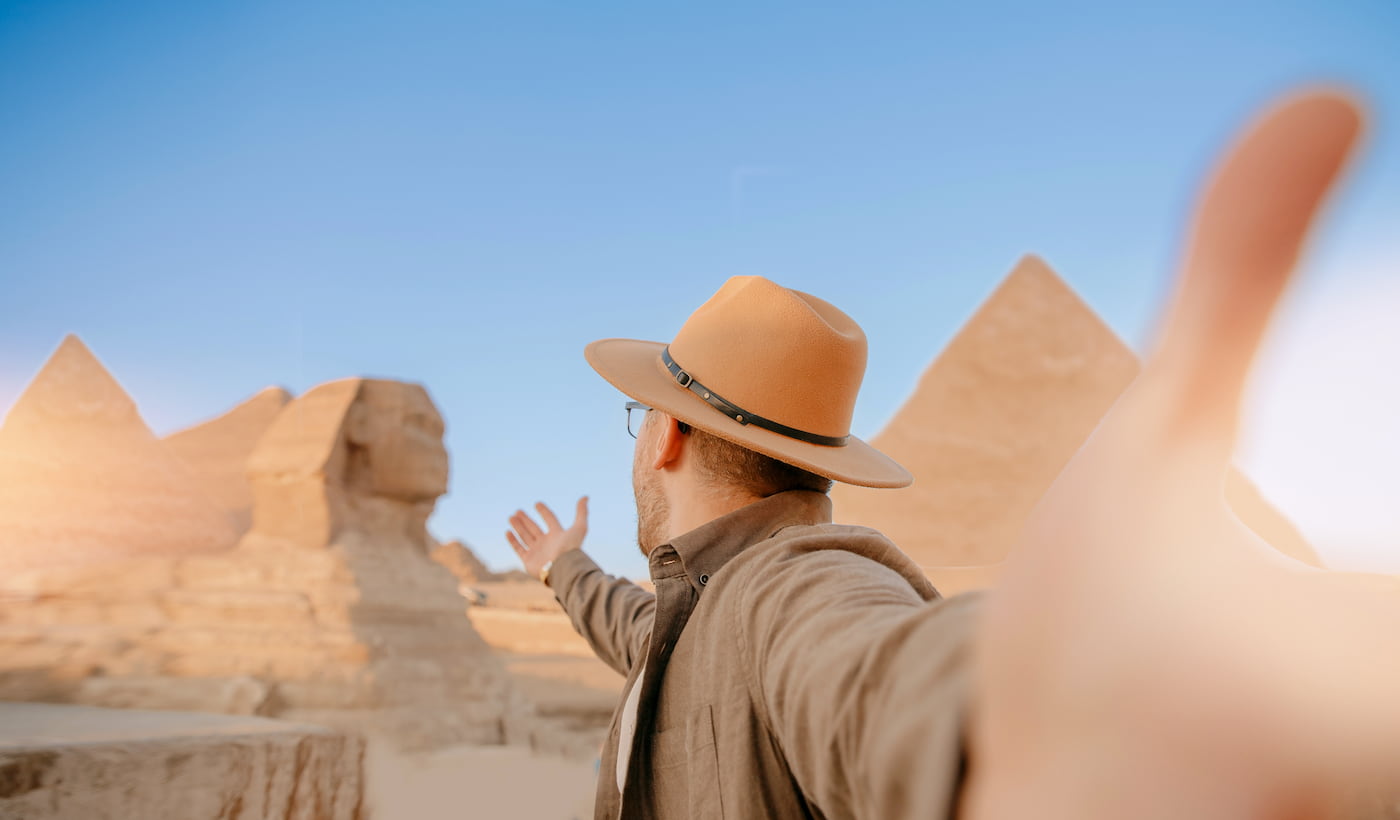Who Is Hathor? The Complete Guide to Egypt’s Goddess of Love and Music
Hathor Goddess of Egypt, stands out as another among the countless revered pagan goddesses of Egyptian mythology. The goddess was depicted as both an estranged mother and joyful guardian of life that brought forth smiles and merriness in the lives of those who revered her for thousands of years. Her name, as interpreted by some historians, states with meaning “House of Horus,” directly associating the goddess with the God Horus. She is depicted in Egyptian art by a female figure crowned by cow horns, which are connected with the sun disk, symbolically reflecting her celestial power.
In other unique roles (those of the Eye of Ra and the Lady of the West), Hathor, Goddess of Egypt, also symbolized the protective stance of wild protectiveness for Ra and also the beautiful reconciliation of mourners or sent-off souls into the afterlife. Most of these houses of the goddess, especially the Hator Temple at Dendera, existed as centers for devotion, music, and healing during her period.
In this article, we can look into who Hathor was, what her myths are, what the symbols are, where the temples stand, and the remaining legacy of the deity to find out why it really remained one of the most celebrated Egyptian deities.
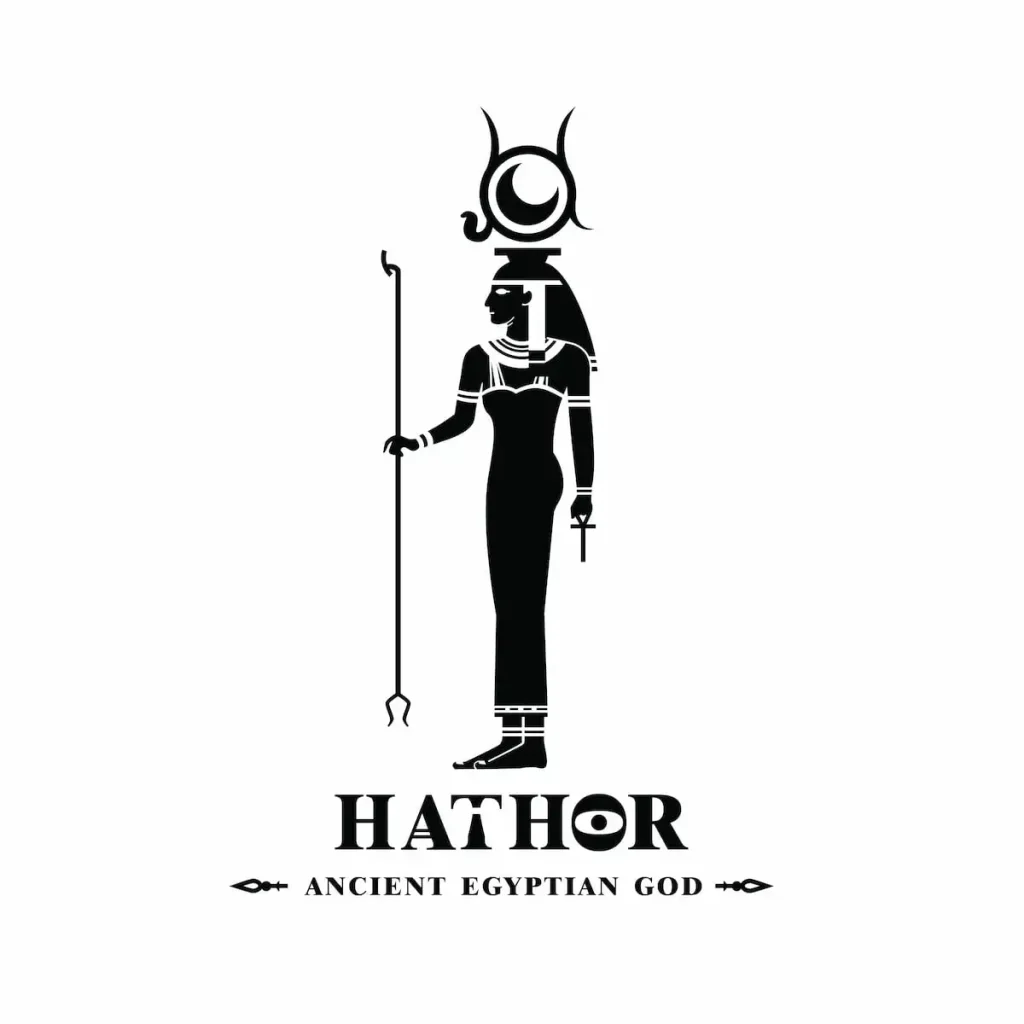
1. Who Is Hathor in Egyptian Mythology?
She ranked as one of the most important deities that were worshipped almost everywhere in ancient Egypt.
Most importantly, she was a goddess known for her exceptional beauty indisputably associated with love, beauty, music, dance, fertility, and motherhood, related to, if not giving joy, in her very essence, release of positive energy from your very inner most core, elevating you to one step closer to where the sacred soo within you is guiding you. She was also supposed to have cosmic powers, given that she was considered the sky goddess, her relationship to Ra as the Eye of Ra, protecting Ma’at, linking her to them. Lastly, Ancient Egypt Games and Music Entertaiments you Should Know About
Her name means ‘House of Horus’ and was moved by this falcon god Horus; she was called that while she is believed to be both mother and lover. It shows the dual character of her Egyptian religion-representational heavenly mother, king’s beloved-slash-protector, and goddess of pleasure with sensuality.
Hathor, Goddess of Egyp,t was a god who was worshiped by all, less only by the elite the widows, mothers, workers, and those who played varied other roles. For example, musicians now approached her in seek of blessings.
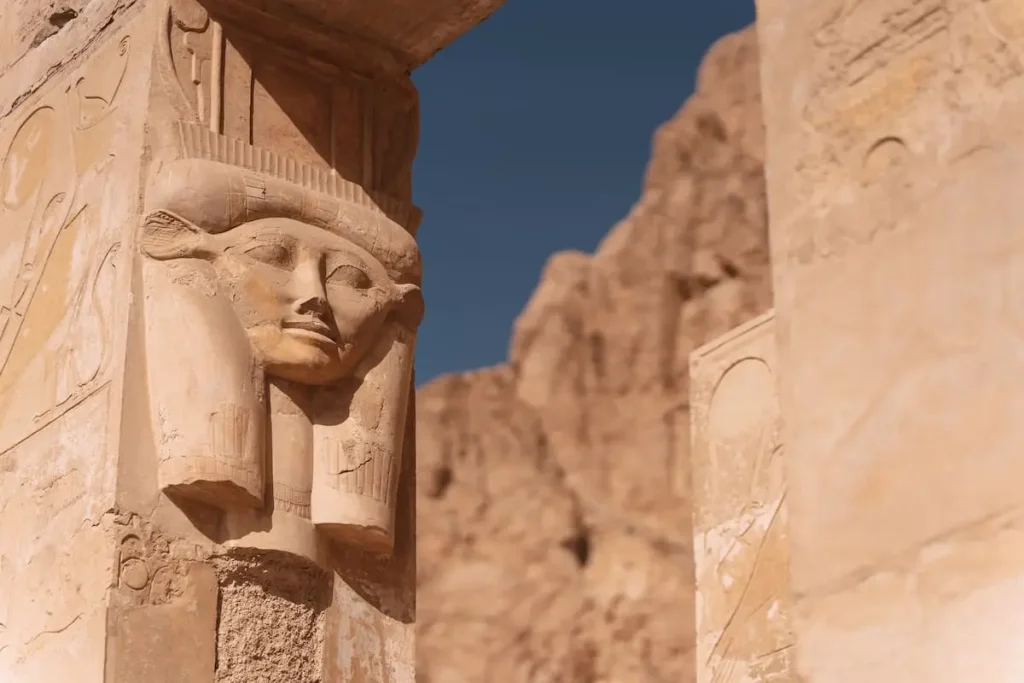
2. The Origins and Meaning of Hathor’s Name
The word Hathor means “Het-Heru”, or “Dwelling of Horus”. She is named after a close relationship with the falcon god of Egyptian mythology, Horus. Some people say Hathor Goddess of Egypt, was his mother in tradition, and others say she was his wife. Regarding this bifocal view, the goddess grew in complexity while she was both a guide and also connected to love.
Behind the sign, there is a deeper thought that tells us, “House of Horus.” This means actually a shelter in heaven where Horus was supposed to build in the construct of the goddess-worshiped and shielded the divine kingship. Most of the pharaohs would call themselves “Living Horus,” to make Hathor the mother of the god and, at the same time, the protector of the king of Egypt.
While the term “Hathor” itself suggested that she was not only the greatest idealized mother figure, but an entity toward which the mothers and common people loved. Even workers, musicians, and the foreign community of a fine city embraced this combination. The word Hathor would thus acquire a connotation in the Egyptian spiritual tradition, emblem of motherhood and protection, and deeply joyed in.

3. Roles and Powers of Hathor, Goddess of Love and Motherhood
Indeed, Hathor epitomized one of the most flexible Egyptian divinities; she practically touched life everywhere with her functions. This is why she was esteemed chiefly as a goddess of love and beauty, dance and music, fertility and motherhood(even by men). One particularly defining function of hers was her strength as a mother, for she watched over children, guided and watched over pregnant women during childbirth.
Even within family life, Hathor stretches out in some ways. For her influence reached far beyond the protection of people in her care. It spread out to mirth and rejoicing, with many a call for mirth and celebration when it was festival-time, feast-time, and sacred celebration as music and dance became the focal point. Musicians and dancers took inspiration and blessing from her, with the sistrum and menat necklaces contributing to the sacred instruments of her worship.
A supreme degree of power is represented in the cosmic aspect of Hathor. In the Egyptian pantheon, she was not described as the mother goddess alone, but also as the divine force of protection and vengeance, joining the Eye of Ra, allowing Ma’at (order) to reign in the world. In this extremely nurturing and ferocious manner, she represented throughout her existence the balance of the Divine.
Hathor was not just the goddess of love but also represented that cosmic figure of protection, joy, and harmony. She demonstrated not only would be sweetness of life would be pure, but that all the Holy Ones abided by order.
4. Famous Myths and Stories About Hathor
That makes us wonder where exactly Hathor plays the most important role because, until now, there has been a huge repertoire of mythologies that featured her. Many of the stories told about her fierce protective side, and there are some on the all-nurturing side as well.
The most popular is the myth concerning the Eye of Ra. Hathor then became Sekhmet’s double. In Sekhmet, Ra transformed another goddess: a wild human in nature, the lioness. Hathor, having become this sharp-eyed, clever goddess, became so widespread that the gods were afraid Egypt would be destroyed. They devised a plan: they brewed beer made red so as to appear like blood, which they gave her to honorably drink. This caused her to become drunk. She returned to her happy, “into-it” form, and all other things were safe as civilization was saved and normality restored. The story exists to deal with her anger and benevolence.
In certain versions of the myth, Hathor plays the role of Horus’s mother; in some cases, however, represented as his consort. This ambiguity is a necessary consequence of his dual role as a cosmic mother and fertility and love goddess.
The funerary narratives depict Hathor as in the netherworld “Lady of the West.” She received the dead into the afterlife, stepping forth from a sycamore tree and giving them water so that they might feel more comfortable in the hereafter.
Hathor emerged as a goddess of joy, love, fertility, and protection in the story that sprang from these often weird visions, but which nonetheless consolidates such a greatly conquering power of defense against cosmic disorders likely to prevail against them.
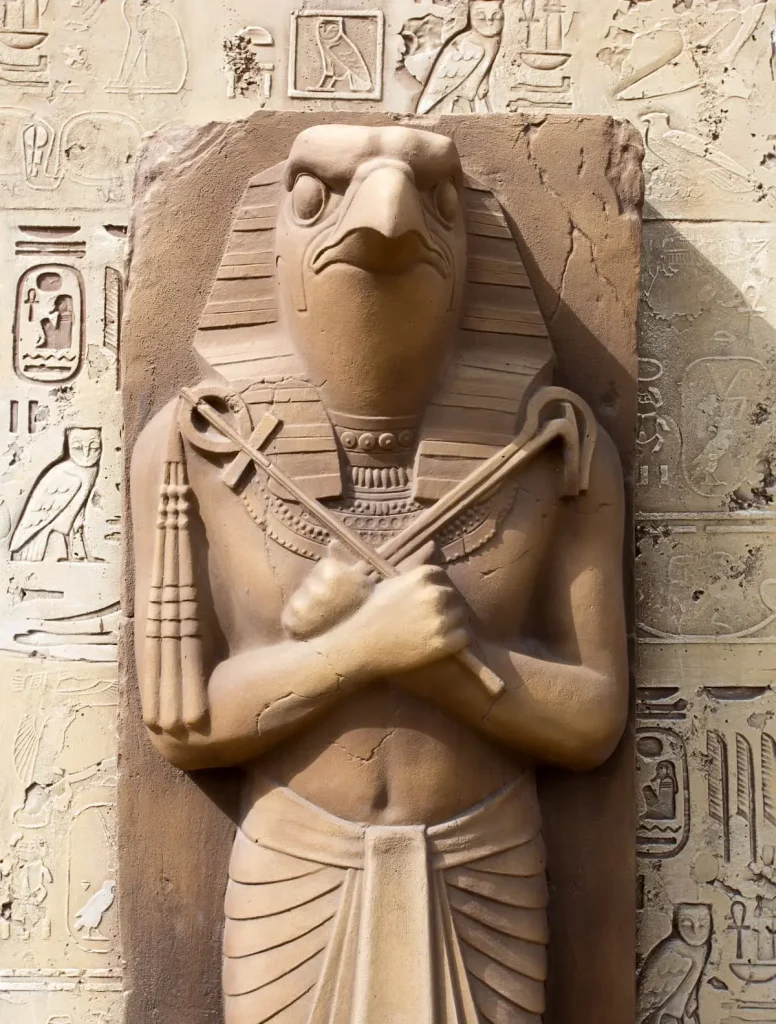
5. Hathor Symbols and Iconography Explained
The name Hathor-Goddess itself means cow or a woman with a cow’s ear, further suggesting a connection to nurturing qualities. She customarily wore a crown with cow horns and a sun disk to denote that, generally, such a title meant that she was always associated with the solar god Ra, the Eye of Ra.
The rattle would have been the leading piece that established her emotional qualities used in both temple and celebration ceremonies. Another important emblem of the collection was the menat necklace, symbolizing fertility, renewal, and protection. Thus, all the women and musicians of Hathor’s temples, of which there were many out there, had both these objects on festive occasions.
The other face of Hathor’s imagery comes from embellishments in architecture, for example, many temples, notably those in Dendera, have columns on which a capital showing the face as well as cow’s ears of Hathor appeared. This clearly illustrates the importance of Hathor as the divinity who occupies the center of the design of sacred spaces.
Thus, eventually her signs became universal; an oracle that every devotion with adornment, temple carving, or sound-making instrument took part in, as it was that far ubiquitous in Egyptian life: from personal adornment to grand religious ceremonies.
6. Temples of Hathor: Worship at Dendera and Beyond
Though Hathor was venerated throughout Egypt, the Temple of Hathor at Dendera remained her prime grove and cult center. The complex was one of the best preserved and studied monuments of the ancient Egyptian era. It was not solely a temple, with several buildings disposed around great courtyards, but a living cultural complex where music was commonly performed during festivals held in her name, and where healing was performed.
The Dendera Temple is particularly proud of its wonderful ceiling, etched with astronomical designs and columns carved with Hathor heads-emitting the aura of a mother goddess with nurturing and protective connotations. It was the scene of great festivals in which the statue of Hathor was carried in procession to join Horus of Edfu in ceremonies of love and fertility.
Keeping in mind other sites, Hathor worship ventured far and wide from Dendera. Thebes, Memphis, Philae, and Byblos all had shrines dedicated to her, which shows that she was well-known in neighboring lands. Her worship was so wide that nobles and commoners alike would invoke her favor.
It was then that the temples came to spearhead merry-making and healing, connecting with the divine in their quest for love, fertility, and safe childbirth, as well as divine protection in their relinquishment and crossing into the threshold of life.

7. Hathor and the Pharaohs: Protector of Kingship
Not only was Hathor a goddess of love and motherhood, but she also served as a protector of kingship in ancient Egypt. Usually, Pharaohs would identify themselves with Hathor, for she stood as a symbol of divine legitimacy and royal protection. Temple reliefs seldom depict goddesses embracing the king, nursing him with divine milk, or crowning him with authority-the few examples served to highlight the sacred authority of the king to rule.
Hathor is very closely related to the idea of the “Divine Birth” of the king. In this version of symbolism, animals would appear as mother and nurse to the pharaoh. This tended to make his power come directly from the gods, thereby accentuating the already strong association between Hathor and the throne to an extent where she, in a way, was regarded as a celestial mother whose presence supported the rulers of Egypt.
The mysterious Seven Hathors were also supposed to meet at the time of a child’s birth to determine his fate. This would, along with her royal destiny, place an even stronger accent on Hathor and her promise of prosperity for the pharaoh.
Thus, Hathor was not only a goddess beloved by her worshippers but also a vital part of royal ideology that unites earthly kingship and the divine order to secure that the ruler-pharaoh became an incarnation of cosmic Ma’at.
8. Hathor and Other Goddesses: Isis, Sekhmet, and Bastet
This overlap of influences of Hathor upon the mighty goddesses of Egyptian divinities showcases the fluid interconnectivity of the entire Egyptian pantheon. Some of these attributes could sometimes be shared with the likes of Isis Goddess, Sekhmet, and Bastet, each being told to incarnate a facet of Hathor’s personality.
Like Isis, Hathor was a mother goddess. While Isis was esteemed as the devoted wife and magical protector of Osiris and Horus, Hathor gave joy and sensual pleasures and nurtured. Sometimes the two goddesses would change places in the religious texts, with Hathor taking over the maternal traits from Isis while Isis took over those aspects of Hathor dealing with fertility and music.
Hathor and Sekhmet occupy two ends of the scale in divine power: Sekhmet, in that sense, was Hathor’s antitype in the myth of the Eye of Ra, Sekhmet standing for war and destruction. Out of wrath, Hathor manifested herself as Sekhmet to destroy mankind; yet once restrained, the dark forces melted away, and joy was incarnated in Hathor, showing that wrath and love are part of one entity.”
The feminine destructive energies link Hathor with Bastet. Bastet stood for the home, pleasure, and fertility, just as those conceptions aspects cast into joy and nurture by Hathor. There is also some commonality between these two goddesses in their association with music, dancing, and festivals, engaged in all the pleasures of life.
Hence, Hathor can be characterized as a confluence whereby these great goddesses merge: married with the nurturance of Isis, the rampant anger of Sekhmet, and the raucous laughter of Bastet, making her one of the most versatile and beloved deity figures of the whole of ancient Egypt.
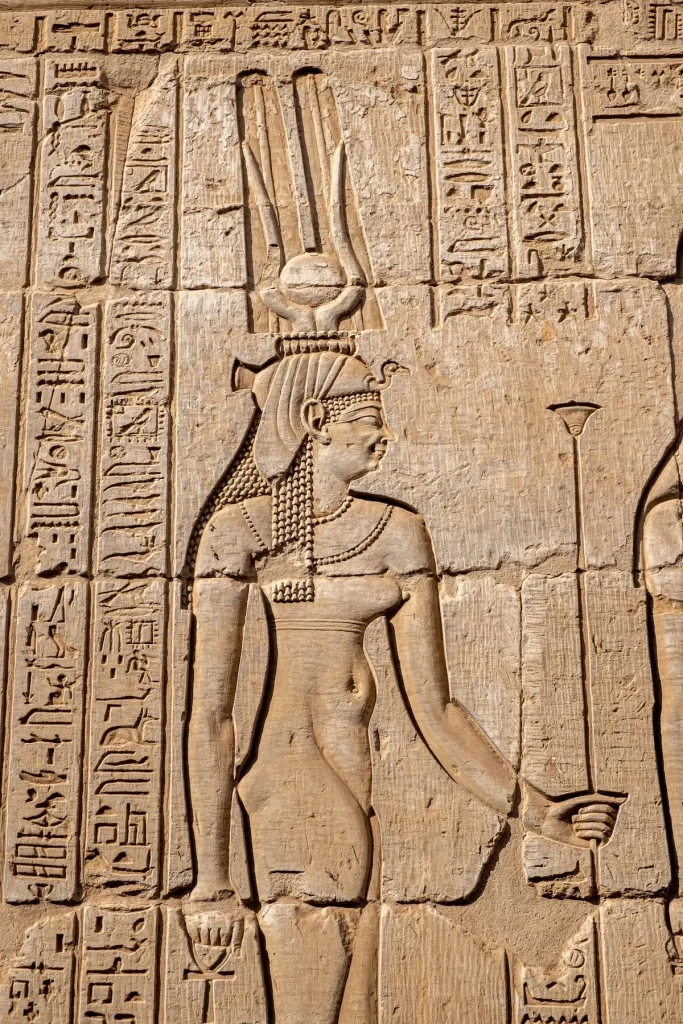
9. Hathor in Ancient Egyptian Art, Music, and Culture
Temples were the proper sites for worship, but hers was also an art, music, and folk worship. Thus, expressing her lovable and motherly nature in so many ways was the reason she became the Egyptian’s most frequently drawn female deity.
Hathor’s artistic representations ranged from bovine-full to various combinations of bovine-human forms-with the smallest distinction lying in a woman with cow ears and the most embellished in the headdress of horns and sun-disk. Statues of her, representing fertility, love, or divine protection, were carved; the images of the goddess were inscribed on the walls of temples and tombs. Hathoric capitals are columns adorned with her visage; this type of architecture reached its greatest acclaim in the Temple of Dendera.
Hathor was the real goddess of gaiety and revelry that had to do with music and dance. The priestesses and musicians would perform the rites with the rattling of sistrums and menat necklaces, recanting evil spirits to be driven away and the spirit to moments of joy. The Egyptians associated the music and dances of Hathor with great occasions such as games, weddings, and other community happenings.
In Egyptian culture and entertainment, Hathor was important for women, artists, and travelers. Prayers were said for becoming beautiful, fertile, bearing safely, and the truly happy. Hathor is therefore not just a myth: She made art, inspired music, and carried the heavy values of joy, peacefulness, and divine connection.

10. Daily Life: Why Hathor Was Loved by the Egyptian People
Hathor was the divine mother of temples and royal ceremonies; in short, having an established temple or royal ceremony would confer the general name of “Hathor.” Usually, there was a fairly puritanical view that in those days, many of the gods were worshipped strictly by priests or care groups, but the fact that common people worshiped Hathor elevated her into one of the greatest goddesses of the ancient world.
Hence, Hathor was another goddess of beauty and fertility who would watch over a woman in childbirth. The mothers called for the safety of their children, the young girls called for their love to be granted to them, and favorable marriages were wished for. The masses carried amulets in the form of the menat necklace or Hathor’s face to bring and attract good fortune, or just to ward off bad luck.
The working class and artisans worshipped Hathor. Before embarking on their artistic ventures, musicians and dancers would seek her blessing, thus acknowledging their art as a gift from the gods. In the Sinai Desert, miners called her the “Lady of Turquoise” because she was patroness of the turquoise mines and protector of the workers in their hazardous conditions.
Hence, Hathor-Goddess ruled down through every section of society from palace to bazaar, from field to mine. Her qualities were fun, love, protection, and luck-a dear heart and widely worshiped goddess of ancient Egypt.
11. Hathor in the Afterlife: Lady of the West and Guide of Souls
In some old mythology, she was the goddess of love and gladness on earth, but contrary to most views about her, she had some responsibilities relating to the afterlife. The Lady of the West was expected to receive the souls of the dead on their way to the other world. Indeed, tomb inscriptions and wall paintings show, quite often, Hathor coming out of the western hills with open arms to welcome the deceased or to offer refreshments to ease their onward journey.
This soft one would also protect the souls as they made their way through the underworld while comforting them in regard to Osiris’ judgment. Hence, most Egyptians would seek the blessings of Hathor in life while also asking for a smooth and safe journey in death.
Also depicted as a cow in the arts and funerary rituals, she is connected with nourishment and rebirth at the threshold of the underworld. The sycamore associated with her was considered a sacred tree that provided food, water, and shelter to any needy spirit.
Hathor assured that in the afterlife, death is not the end but rather a rebirth into a further life with her gentle embrace. She thus remained a very vital being for the ancient ones both in life and in death.
12. Interesting Facts About Hathor, Egyptian Goddess of Love and Music
Hathor’s worship spanned thousands of years, and her mythology is full of fascinating details. Here are twelve key facts that show why she was one of the most beloved goddesses in ancient Egypt:
-
One of the Oldest Deities: Hathor’s worship dates back to the Early Dynastic Period, making her one of Egypt’s earliest and most enduring goddesses.
-
Her Name Means “House of Horus”: The name Hathor (Het-Heru) translates to House of Horus, highlighting her role as both the mother and consort of the falcon god Horus.
-
Goddess of Many Aspects: Hathor was simultaneously a goddess of love, music, fertility, dance, beauty, joy, and motherhood, embodying life’s pleasures.
-
Protector of Women and Mothers: Women prayed to Hathor for fertility, safe childbirth, and maternal guidance.
-
Lady of Music: The sistrum, a musical rattle, was her sacred instrument, and rituals in her temples always included music and dance.
-
Symbols of Power: Hathor was associated with cows (nurturing), lionesses (fierce protection), and cobras (royal power).
-
Linked to the Sky and Sun: As the “Eye of Ra,” Hathor could act as a protective solar goddess, defending the sun god against his enemies.
-
Role in the Afterlife: Known as “Lady of the West,” she guided souls into the next world, offering comfort to the dead.
-
Universal Goddess: Hathor was worshipped by both the royal elite and ordinary Egyptians—pharaohs, priests, workers, musicians, and mothers alike.
-
Her Dual Nature: Hathor was both nurturing and dangerous; in the “Eye of Ra” myth, she transformed into Sekhmet, a lioness of destruction.
-
The Dendera Temple: Her most famous cult center was at Dendera, where one of the best-preserved temples in Egypt still stands today.
-
Influence Beyond Egypt: Hathor’s worship spread into Nubia and even influenced goddesses in Greek and Roman traditions, such as Aphrodite and Venus.
13. Archaeological Discoveries Linked to Hathor
It’s written in the historical records already that the cult of half-cow half half-woman was extremely well-established and deeply entrenched in the land of ancient Egypt. There have been quite a few fantastic relics like reliefs, colossal sculptures, and even the famous Dendera Zodiac, combining astronomical knowledge with religious principles, dug up during the excavations in the main temple of Hathor at Dendera. The temple is well preserved and one of the most intact in Egypt. Thus, visitors today can enjoy its design and learn how the worship of Hathor evolved over almost two centuries.
Moreover, Hedet (Dendera) also contained other representations dedicated to Hathor. There lie the Serabit el-Khadim mines in the Sinai, and it became famous for the extensive evidence of shrines to the goddess on site. The basic rituals performed by the miners include praying for safety and success before starting work while thinking of the ‘Lady of Turquoise’. These discoveries are a testament to the fact that her cult was not limited to the cities but also reached even some of the most arid and isolated regions of the desert.
Sistra-like musical rattles, amulets that are shaped like cows, and oblations that are associated with Hathor have been found inside many tombs and temples in Egypt. Her stature as a deity of delight, preservation, and the hereafter only increases with each find.
When all is said and done, contemporary archaeology gives us evidence of Hathor’s great popularity with the ancient population and how her all-encompassing persona was held in high esteem as it permeated various aspects of the Egyptian culture, be it from personal worship to the astronomical beliefs.
14. Conclusion: Why Hathor Remains Egypt’s Beloved Goddess
Hathor Goddess of Egypt, is seen as one of the most beloved and extraordinary aspects of ancient Egyptian religious belief. She is more than just the goddess of beauty and love; she is the goddess of ancient Egypt, patron of music, childbearing, and medicine, and the divine mother of the afterlife. This explains why Hathor was a goddess adored not only in temples but by every individual throughout Egypt, hence, appropriately referred to as the motherly and protecting goddess. Seen as performing certain roles, then it was possible that she could only be considered as representing one extreme of a binary concept, such as life and death, the divine and human, or the ruling and ruled.
Looking further, there were numerous sanctuaries and cult idols of Hathor, testimony to her widespread role in ancient Egyptian religion and learning. She is the House of Horus, the Eye of Ra, and the Lady of the West, all attesting to the order of things. However, her behaviour pattern as a bearer of music, dance, and jubilation or despair anthropomorphizes her further in tasks of joy and art.
The synonyms that mean Hathor continue to exist. It is a perfect description of how people still try to attain love, dignity, and happiness. It is in such a person represents the movement of one being to look after and cherish others and allow themselves to be cherished by others, appreciating and searching for happiness, hence she is celebrated with her name against the backdrop of an Egyptian civilization that has taken shape over the years.

